Google Trends is a surprisingly useful tool for keyword research, especially when using advanced search options that are virtually hidden in plain sight.
Explore the different Google Trends menus and options and discover seemingly endless ways to gain more keyword search volume insights.
Learn new ways to unlock the power of one of Google’s most important SEO tools.
The Value Of Google Trends
While Google Trends is accurate, it doesn’t show the amount of traffic in actual numbers.
It shows the numbers of queries made in relative percentages on a scale of zero to 100.
Unlike Google Trends, paid SEO tools provide traffic volume numbers for keywords.
But those numbers are only estimates that are extrapolated from a mix of internet traffic data providers, Google Keyword Planner, scraped search results, and other sources.
The clickstream data usually comes from anonymized traffic data acquired from users of certain pop-up blockers, browser plugins, and some free anti-virus software.
The SEO tools then apply a calculation that corresponds to their best guess of how that data correlates with Google keyword search and traffic volume.
So, even though paid SEO tools provide estimates of keyword traffic, the data presented by Google Trends is based on actual search queries and not guesses.
That’s not to say that Google Trends is better than paid keyword tools. When used together with paid keyword tools, one can obtain a near-accurate idea of true keyword search volume.
There are other functions in Google Trends that can help dial in accurate segmentation of the keyword data that helps to understand what geographic locations are best for promotional efforts and also discover new and trending keywords.
How To Use Google Trends For SEO
1. Get More Accurate Data By Comparing Keywords
Google Trends shows a relative visualization of traffic on a scale of zero to 100.
You can’t really know if the trend is reporting hundreds of keyword searches or thousands because the graph is on a relative scale of zero to one hundred.
However, the relative numbers can have more meaning when they are compared with keywords for which there are known traffic levels from another keyword phrase.
One way to do this is to compare keyword search volume with a keyword whose accurate traffic numbers are already known, for example, from a PPC campaign.
If the keyword volume is especially large for which you don’t have a keyword to compare, there’s another way to find a keyword to use for comparison.
A comparison keyword doesn’t have to be related. It can be in a completely different vertical and could even be the name of a trending celebrity.
The important thing is the general keyword volume data.
Google publishes a Google Trends Daily Trends webpage that shows trending search queries.
What’s useful about this page is that Google provides keyword volumes in numbers, like 100,000+ searches per day, etc.
Example Of How To Pinpoint Search Volume
I’m going to use the search phrase [how to lose weight] as an example of how to use Google Trends to get a close idea of actual search volume.
The way I do it is by using known search volumes and comparing them to the target keyword phrase.
Google provides search volumes on its trending searches page, which can be adjusted for what’s trending in any country.
On this particular day (September 22, 2022), the actress Ana De Armas was trending with 50,000+ searches, and the American ex-football player (keyword phrase [Bret Favre News]) was trending with 20,000+ searches.
Step 1. Find Search Trends For Target Keyword Phrases
The target keyword phrase we’re researching is [how to lose weight].
Below is a screenshot of the one-year trend for the target keyword phrase:
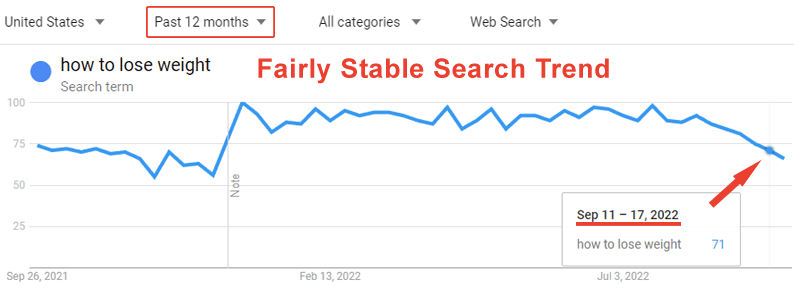 Screenshot from Google Trends, September 2022
Screenshot from Google Trends, September 2022
As you can see, it’s a fairly stable trend line from September 2021 to September 2022.
Then I added the two keyword phrases for which we have a close search volume count to compare all three, but for a 24-hour time period.
I use a 24-hour time period because the search volume for our comparison keywords is trending for this one day.
 Screenshot from Google Trends, September 2022
Screenshot from Google Trends, September 2022
Our target keyword phrase, with a red trend line, is right in the middle, in between the keyword phrases [Ana De Armas] (blue) and [Bret Favre News] (yellow).
What the above comparison tells us is that the phrase [how to lose weight] has a keyword volume of more than 20,000+ searches but less than 50,000+ searches.
The relative search volume of [how to lose weight] is 50% of the keyword phrase [Ana De Armas].
Because we know that [Ana De Armas] has a search volume of approximately 50,000+ searches on this particular day, and [Bret Favre News] has a search volume of 20,000+ queries on the same day, we can say with reasonable accuracy that the keyword phrase, [how to lose weight] has approximately a daily search volume of around 30,000 on an average day, give or take a few thousand.
The actual numbers could be higher because Google Trends shows the highs and lows at particular points of the day. The total for the day is very likely higher.
The above hack isn’t 100% accurate. But it’s enough to give a strong ballpark idea and can be used to compare with and validate extrapolated data from a paid keyword research tool.
Related: How To Do Keyword Research For SEO
2. Discover Insights From Time-based Trends
There are two general ways to look at the keyword data: stretched across over longer periods of time and shorter time periods.
Long Period Trends
You can set Google Trends to show you the traffic trends stretching back to 2004. This is valuable for showing you the audience trends.
- Upward Long-Term Trends: If a trend is consistently going up, this means you need to focus energy on creating content for this trend.
- Downward Long-Term Trends: If the trend line is steadily moving down, then it may be a signal that audience content consumption is changing.
For example, review this five-year trend for [WordPress] the search term, WordPress the software, and WordPress the website:
 Screenshot from Google Trends, September 2022
Screenshot from Google Trends, September 2022
There’s a clear downward trend for WordPress in all three variations.
The downward trend extends to related phrases such as:
- WordPress themes.
- WordPress plugin.
- WordPress hosting.
There are many reasons why search trends go down. It can be that people lost interest, that the interest went somewhere else or that the trend is obsolete.
The digital camera product category is a good example of a downward spiral caused by a product being replaced by something else.
- The digital camera caused the downturn in searches for traditional analog cameras.
- The iPhone started the downward spiral of the digital camera.
Knowing which way the wind is blowing could help a content marketer or publisher understand when it’s time to bail on a topic or product category and to pivot to upward-trending ones.
Related: Content Marketing: The Ultimate Beginner’s Guide
3. Related Topics And Queries
Google Trends has two great features, one called Related Topics and the other Related Queries.
Topics
Topics are search queries that share a concept.
Identifying related topics that are trending upwards is useful for learning how an audience or consumer demand is shifting.
This information can, in turn, provide ideas for content generation or new product selections.
According to Google:
“Related Topics
Users searching for your term also searched for these topics.
You Can View by the Following Metrics
Top – The most popular topics. Scoring is on a relative scale where a value of 100 is the most commonly searched topic and a value of 50 is a topic searched half as often as the most popular term, and so on.
Rising – Related topics with the biggest increase in search frequency since the last time period.
Results marked “Breakout” had a tremendous increase, probably because these topics are new and had few (if any) prior searches.”
Related Queries
The description of Related Queries is similar to that of the Related Topics.
Top queries are generally the most popular searches. Rising Queries are queries that are becoming popular.
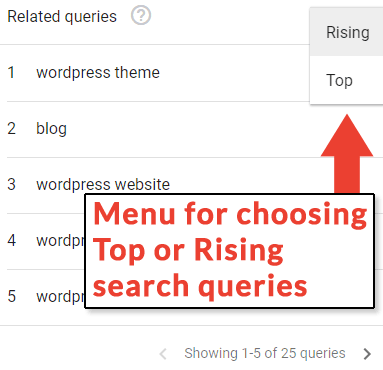 Screenshot from Google Trends, September 2022
Screenshot from Google Trends, September 2022
The data from Rising Queries are great for staying ahead of the competition.
4. Short-Term Trends Can Bring Massive Traffic
Viewing keyword trends in the short view, such as the 90-day or even 30-day view, can reveal valuable insights for capitalizing on rapidly changing search trends.
There is a ton of traffic in Google Discover as well as in Google News.
Google Discover is tied to trending topics related to searches.
Google News is of the moment in terms of current events.
Sites that target either of those traffic channels benefit from knowing what the short-term trends are.
A benefit of viewing short-term trends (30 days and 90 trends) is that certain days of the week stand out when those searches are popular.
Knowing which days of the week interest spikes for a given topic can help in planning when to publish certain kinds of topics, so the content is right there when the audience is searching for it.
5. Keywords By Category
Google Trends has the functionality for narrowing down keyword search query inventory according to category topics.
This provides more accurate keyword data.
The Categories tab is important because it refines your keyword research to the correct context.
If your keyword context is [automobiles], then it makes sense to appropriately refine Google Trends to show just the data for the context of auto.
By narrowing the Google Trends data by category, you will be able to find more accurate information related to the topics you are researching for content within the correct context.
6. Identify Keyword Data By Geography
Google Trends keyword information by geographic location can be used for determining what areas are the best to outreach to for site promotion or for tailoring the content to specific regions.
For example, if certain kinds of products are popular in Washington D.C. and Texas, it makes sense to aim promotional activity and localized content to those areas.
In fact, it might be useful to focus link-building promotional activities in those areas first since the interest is higher in those parts of the country.
Keyword popularity information by region is valuable for link building, content creation, content promotion, and pay-per-click.
Localizing content (and the promotion of that content) can make it more relevant to the people who are interested in that content (or product).
Google ranks pages according to who it’s most relevant, so incorporating geographic nuance into your content can help it rank for the most people.
7. Target Search Intents With Search Types
Google Trends gives you the ability to further refine the keyword data by segmenting it by the type of search the data comes from, the Search Type.
Refining your Google Trends research by the type of search allows you to remove the “noise” that might be making your keyword research fuzzy and help it become more accurate and meaningful.
Google Trends data can be refined by:
- Web Search.
- Image Search.
- News Search.
- Google Shopping.
- YouTube Search.
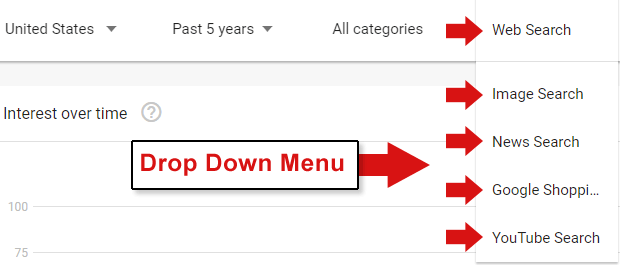 Screenshot from Google Trends, September 2022
Screenshot from Google Trends, September 2022
YouTube search is a fantastic way to identify search trends for content with the word “how” because a lot of people search on YouTube using phrases with the words “how” in them.
Although these are searches conducted on YouTube, the trends data is useful because it shows what users are looking for.
A Google Trends search for how, what, where, when, why, and who shows that search queries beginning with the word “how” are by far the most popular on YouTube.
Google Trends limits comparisons to five keywords, so the following screenshot omits that word.
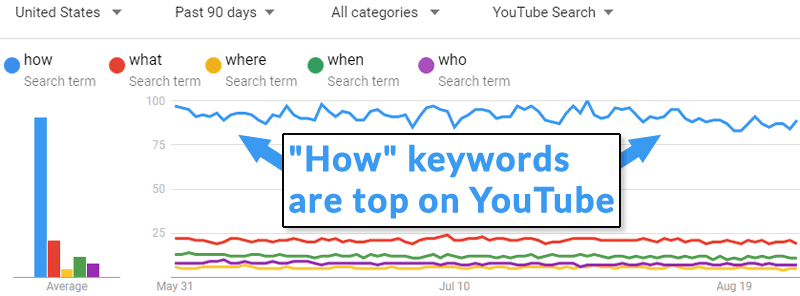 Screenshot from Google Trends, September 2022
Screenshot from Google Trends, September 2022
If your keyword phrases involve instructional content that uses words like “how to,” refining your research with the YouTube search type may provide useful insights.
For example, I have found that YouTube Search shows more relevant “related topics” and “related queries” data than researching with “web search” selected.
Here’s another example of how using different kinds of search types helps refine Google Trends data.
I did the same how, what, where, when, why, and who searches but this time using the News Search refinement.
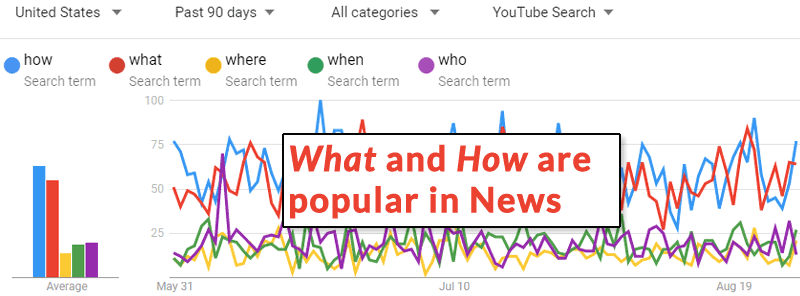 Screenshot from Google Trends, September 2022
Screenshot from Google Trends, September 2022
The search trends in Google News are remarkably different than the search patterns on YouTube. That’s because people want to know the “what” and “how” types of information in Google News.
When creating content related to news, identifying the correct angle to report a news item is important.
Knowing that the words “what” or “who” are most relevant to a topic can be useful for crafting the title to what the readers are most interested in.
The above is the view of search queries for the past 90 days.
When the same keywords are searched using the 5-year perspective, it becomes clear that the “who” type keywords tend to spike according to current events.
As an example of how current events influence trends, the biggest spike in searches with the word “who” occurred in the days after the 2020 presidential election.
Every Search Type query refinement shows a different help to refine the results so that they show more accurate information.
So, give the Search Type selections a try because the information that is provided may be more accurate and useful than the more general and potentially noisy “web search” version.
Unlock The Hidden Power Of Google Trends
Free tools are generally considered to be less useful than paid tools. That’s not necessarily the case with Google Trends.
This article lists seven ways to discover useful search-related trends and patterns that are absolutely accurate, more than some search-related data from paid tools.
What’s especially notable is that this article only begins to scratch the surface of all the information that’s available.
Check out Google Trends and learn additional ways to mix different search patterns to obtain even more useful information.
More Resources:
Featured Image: Studio Romantic/Shutterstock
